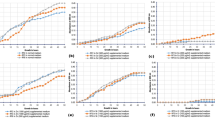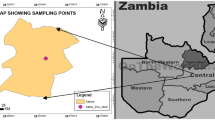Abstract
In the present study, a metal-tolerant fluorescent pseudomonad isolated from uranium ore rich deposit of Domiasiat in North-East India was identified as Pseudomonas aeruginosa DPs-13 based on morphological, biochemical and molecular analysis. The isolate showed higher tolerance to uranium and other metals like copper, cadmium, zinc and lead when compared with the reference strain P. aeruginosa MTCC2474. When checked for uranyl bioadsorption potential, the isolate showed 94 % (22.5 mg/L) and 72 % (342.7 mg/L) removal of uranium (VI) when challenged with 100 μM (23.8 mg/L) and 2 mM (476 mg/L) uranyl nitrate solutions within 1 h of incubation as compared to 68 % (16.18 mg/L) and 25 % (119 mg/L) when challenged with above concentrations respectively of uranyl nitrate by the reference strain. The isolate was resistant to most of the commonly used antibiotics like Ampicillin, Kanamycin, Chloramphenicol, Erythromycin, Aztreonam, Tetracycline, Ciprofloxin and Streptomycin. The isolate had no phytotoxic effect, produced siderophores, possessed phosphate solubilising ability as well as two antibiotic producing genes, and had antagonistic activity against plant pathogens. Plasmid occurrence was also noticed in the isolate. The isolate from the uranium ore rich site besides being a promising metal tolerant bacterium had potent plant growth promoting activity and can be used to promote plant growth in bioremediation approaches in metal contaminated sites.






Similar content being viewed by others
References
Moore JW, Ramamoorthy A (1984) Heavy metals in Natural waters: applied monitoring and impact assessment. Springer, New York
Malik A, Ahmad M (1995) Genotoxicity of some waste waters in India. Environ Toxicol Water Qual 10:287–293. doi:10.1002/tox.2530100409
Lloyd J, Lovley D (2001) Microbial detoxification of metals and radionuclides. Curr Opin Biotechnol 12:248–253
Sarma B, Acharya C, Joshi SR (2010) Pseudomonads: a versatile bacterial group exhibiting dual resistance to metals and antibiotics. Afr J Microbiol Res 4:2828–2835
Haferburg G, Kothe E (2007) Microbes and metals: interactions in the environment. J Basic Microbiol 47:453–467
Tripathi P, Srivastava S (2007) Development and characterization of nickel accumulating mutants of Aspergillus nidulans. Indian J Microbiol 47:241–250
Cho Y, Kim JS, Crowley DE, Cho B (2003) Growth promotion of the edible fungus Pleurotus ostreatus by fluorescent pseudomonads. FEMS Microbiol Lett 218:271–276
Preston GM (2004) Plant perceptions of plant growth-promoting Pseudomonas. Philos Trans R Soc Lond B Biol Sci 359:907–918
Sayyed RZ, Patel PR (2011) Biocontrol potential of siderophore producing heavy metal resistant Alcaligenes sp. and Pseudomonas aeruginosa RZS3 vis-a`-vis organophosphorus fungicide. Indian J Microbiol 51:266–272. doi:10.1007/s00284-008-9264-z
Rodríguez H, Fraga R (1999) Phosphate solubilizing bacteria and their role in plant growth promotion. Biotechnol Adv. 17:319–339. doi:10.1016/S0734-9750(99)00014-2
Nair A, Juwarkar AA, Singh SK (2006) Production and characterization of siderophores and application in arsenic removal from contaminated soil. Water Air Soil Pollut 180:199–212. doi:10.1007/s11270-006-9263-2
Sayyed RZ, Chincholkar SB (2010) Growth and siderophore production Alcaligenes faecalis is influenced by heavy metals. Indian J Microbiol 50(2):179–182
Brosius J, Dull TJ, Sleeter DD, Noller HF (1981) Gene organization and primary structure of a ribosomal RNA operon from Escherichia coli. J Mol Biol 148:107–127
Weisburg WG, Barns SM, DA Pelletier Z, Lane DJ (1991) 16S ribosomal DNA amplification for phylogenetic study. J Bacteriol 173:697–703
Altschul SF, Madden TL, Schaeffer AA, Zhang J, Zhang Z, Miller W, Lipman DJ (1997) Gapped BLAST and PSI-BLAST: a new generation of protein database search programs. Nucleic Acids Res 25:3389–3402
Chun J, Lee JH, Jung Y, Kim M, Kim S, Kim BK, Lim YW (2007) EzTaxon: a web-based tool for the identification of prokaryotes based on 16S ribosomal RNA gene sequences. Int J Syst Evol Microbiol 57:2259–2261
Tamura K, Dudley J, Nei M, Kumar S (2007) MEGA4: molecular evolutionary genetics analysis (MEGA) software version 4.0. Mol Biol Evol 24:1596–1599
Tyler SD, Strathdee CA, Rozee KR, Johnson WM (1995) Oligonucleotide primers designed to differentiate pathogenic pseudomonads on the basis of the sequencing of genes coding for 16S–23S rRNA internal transcribed spacers. Clin Diagn Lab Immunol 2:448–453
Savvin SB (1961) Analytical use of arsenazo III: determination of thorium, zirconium, uranium and rare earth elements. Talanta 8:673–685
Kumar R, Acharya C, Joshi SR (2011) Isolation and analyses of uranium tolerant Serratia marcescens strains and their utilization for aerobic uranium U(VI) bioadsorption. J Microbiol 49:568–574. doi:10.1007/s12275-011-0366-0
Schillinger U, Lucke FK (1989) Antibacterial activity of Lactobacillus sake isolated from meat. Appl Environ Microbiol 55:1901–1906
Naik PR, Sahoo N, Goswami D, Ayyadurai N, Sakthivel N (2008) Genetic and functional diversity among fluorescent pseudomonads isolated from the rhizosphere of banana. Microbiol Ecol 56:492–504
Lenka P, Jha SK, Gothankar S, Tripathi RM, Puranik VD (2009) Suitable gamma energy for gamma-spectrometric determination of 238U in surface soil samples of a high rainfall area in India. J Environ Radioact 100:509–514
Burt R, Wilson MA, Mays MD, Lee CW (2003) Major and trace elements of selected pedons in the USA. J Environ Qual 32:2109–2121
Hassen A, Saidi N, Cherif M, Boudabous A (1998) Resistance of environmental bacteria to heavy metals. Bioresour Technol 64:7–15
Mergeay M, Nies D, Schiegel HG, gerits J, Charles P, Van Gijsegem F (1985) Alcaligenes eutrophus CH34 is a facultative chemolithotroph with plasmid-bound resistance to heavy metals. J Bacteriol 162:238–334
Perron K, Caille O, Rossier C, Delden CV, Dumas J, Köhler T (2004) CzcR-CzcS, a two-component system involved in heavy metal and carbapenem resistance in Pseudomonas aeruginosa. J Biol Chem 279:8761–8768
Caille O, Rossier C, Perron K (2007) A copper-activated two-component system interacts with zinc and imipenem resistance in Pseudomonas aeruginosa. J Bacteriol 189:4561–4568
Lim C, Cooksey DA (1993) Characterization of chromosomal homologs of the plasmid-borne copper resistance operon of pseudomonas syringae. J Bacteriol 175:4492–4498
El-Deeb B (2009) Plasmid mediated tolerance and removal of heavy metals by enterobacter sp. Am J Biochem Biotechnol 5:47–53
Raja CE, Selvam GS (2009) Plasmid profile and curing analysis of Pseudomonas aeruginosa as metal resistant. Int J Environ Sci Technol 6:259–266
Schnider-Keel U, Seematter A, Maurhofer M, Blumer C, Duffy B, Gigot-Bonnefoy C, Reimmann C, Notz R, De’fago G, Haas D, Keel C (2000) Autoinduction of 2 4-diacetylphloroglucinol biosynthesis in the biocontrol agent Pseudomonas fluorescens CHA0 and repression by the bacterial metabolites salicylate and pyoluteorin. J Bacteriol 182:1215–1220
Acknowledgments
The financial support received from the Department of Information Technology, Ministry of Communication & Information Technology, Government of India is thankfully acknowledged.
Author information
Authors and Affiliations
Corresponding author
Electronic supplementary material
Below is the link to the electronic supplementary material.
40011_2012_136_MOESM4_ESM.tif
SFig 4:PCR amplification of antibiotic coding gene (A) 2,4-diacetylphloroglucinol (DAPG) and (B) pyoluteorin (PLT) [M = 100 bp molecular marker] (TIFF 180 kb)
Rights and permissions
About this article
Cite this article
Sarma, B., Acharya, C. & Joshi, S.R. Plant Growth Promoting and Metal Bioadsorption Activity of Metal Tolerant Pseudomonas aeruginosa Isolate Characterized from Uranium Ore Deposit. Proc. Natl. Acad. Sci., India, Sect. B Biol. Sci. 84, 157–164 (2014). https://doi.org/10.1007/s40011-012-0136-8
Received:
Revised:
Accepted:
Published:
Issue Date:
DOI: https://doi.org/10.1007/s40011-012-0136-8




